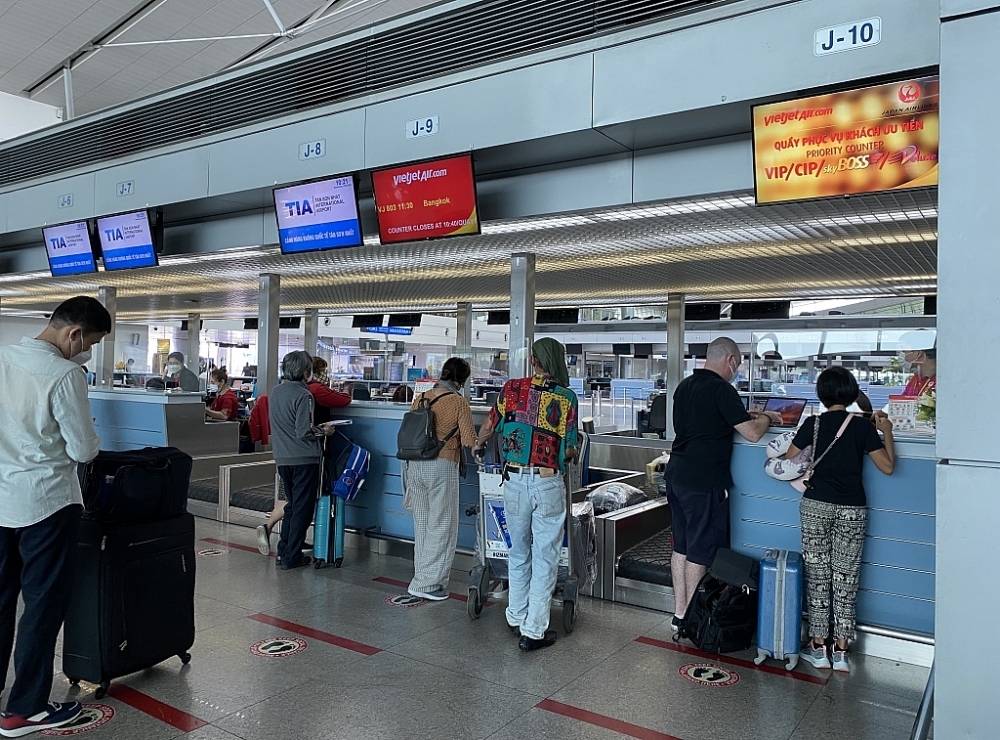 |
| Passengers carry out check-in at Tan Son Nhat International Airport on February 23, 2022. Photo T.D |
Dr. Bui Doan Ne, General Secretary of the Vietnam Aviation Business Association (VABA), said that Vietnamese airlines had operated 305,080 commercial flights in 2022, an increase of 2.34 times compared to 2021 and equal to 90.2% of the corresponding index of 2019, before the outbreak of the Covid-19 pandemic.
As of April 2022, the domestic air transport market had reached the same level as the same period in 2019. 69 domestic routes had been re-operated, opened and increased in frequency by airlines.
Thanks to the boom in travel demand during the peak of the summer period, domestic passenger volume has fully recovered and increased by 40-42% compared to same period of 2019, and in June-August 2022.
In the international market, airlines have restored 118 flight routes, connecting from nine airports in Vietnam to 24 countries and territories around the world, transporting 11 million international passengers.
In addition to increasing capacity, airlines are also quick to gain a head start by taking shortcuts in improving the quality of air services, as well as building new, diversified and attractive product lines to meet the needs of the customers. Thanks to these outstanding efforts, Vietnamese airlines have recorded continuous revenue reaching a record high.
According to the CAAV’s optimistic scenario, Vietnam’s aviation industry can reach a full recovery by the end of 2023. The total air transport market is estimated at approximately 80 million passengers and 1.44 million tons of cargo in 2023, an increase of 45% for passengers and 15% for cargo respectively compared to 2022.
However, according to experts, the recovery of air transport enterprises is still facing many new adverse factors.
Accordingly, the price of jet fuel (Jet A1) continuously skyrocketed in 2022, sometimes reaching over US$160/barrel. On average for the whole year of 2022, the price of jet fuel reached US$130/barrel, an increase of about 80% compared to the average level of 2021. In the immediate period, the price of Jet A1 is still forecast to fluctuate at US$ 110-130/barrel, causing a great disadvantage for airlines in the context that fuel costs account for more than 40% of total operating costs.
Besides, the US dollar’s appreciation of about 9% against the VND in 2022 also puts great financial pressure on airlines, because this is the most commonly used foreign currency to pay operating expenses, such as fees for fuel, aircraft hire, and outsourced services for passengers.
These are all factors that strongly affect the effective price adjustment ability of airlines as well as the whole market. Therefore, in the domestic aviation industry, there is a paradox that despite a strong increase in revenue, many airlines still report negative profits.
Proposal to remove ceiling on air tickets
Standing on the threshold of recovery and development in the new period, besides internal strength, representatives of five Vietnamese airlines (Vietnam Airlines including Vasco, Vietjet Air, Bamboo Airways, Pacific Airlines and Vietravel Airlines) all hoped to receive new support from the Government’s mechanisms and policies so that Vietnam’s aviation industry could recover to the way it was before the Covid-19 pandemic.
According to Mr. Nguyen Manh Quan, General Director of Bamboo Airways, fuel prices and exchange rates, input service prices had all increased, while the prices issued by the State management agencies since 2015 compared to 2023 were already no longer in line with international and domestic changes.
Therefore, the General Director of Bamboo Airways proposed to the Ministry of Transport to urgently consider adjusting the price on the basis of legal regulations according to the actual input factors.
“The ceiling price regulation should be removed for routes that already have three or more operators. The State only manages the routes that are exclusively exploited, the removal of the ceiling price or the increase of the ceiling price not only does not affect consumers but also helps to diversify price policies, helping airlines to have conditions to supply the best quality products to customers,” said Mr. Quan.
Agreeing with the above view, Mr. Trinh Ngoc Thanh, Deputy General Director of Vietnam Airlines, added that the current airfare range was regulated by the Civil Aviation Law, with ceiling and floor prices.
According to Circular No. 36/2015/TT-BGTVT of the Ministry of Transport, the domestic economy-class airfare range had been promulgated since 2015. Since then, the inputs constituting fares had been changed a lot but the price bracket remained unchanged.
Prof. Tran Tho Dat, a member of the Prime Minister’s Economic Advisory Group, analyzed that the airfares were different from the price of ordinary goods. In terms of structure, airfares setting by costs were complicated and these factors fluctuated beyond the control of airlines, such as fuel prices, exchange rates, labor costs.
“Very few countries also apply a ceiling price like Vietnam. Sooner or later, the ceiling price should be removed, and replaced with a wide enough price management formula to ensure an appropriate level of competition,” added Mr. Tran Tho Dat.
